As part of a Covenant Foundation Signature Grant, the Jewish Grandparents Network has reimagined grandparents’ roles in their grandchildren’s B-Mitzvah experiences.
The following piece, created by educators and ritualists Naomi Less and Tehilah Eisenstadt, re-envisions the role grandparents and elders can play in imbuing this coming-of-age ceremony with music, movement, and dance.
**************
Music, movement, and dance are core ingredients in transforming B-mitzvah into a vibrant celebration. They transcend language, tapping into emotional connections that resonate deep inside the heart. As physical expressions of thankfulness and gratitude, they can infuse the B-mitzvah with shared energy and visible joy.
What are the three fundamental elements of rites of passage?
Music, movement and dance can be especially important in navigating the three fundamental elements of rites of passage, as described by early 20th-century anthropologist Arnold Van Gennep. In his seminal work The Rites of Passage, coming-of-age rituals, no matter where they take place around the world, include separation, transition, and reintegration.
 For the B-Mitzvah teen, separation takes place naturally as the teen develops biologically and matures socially into a more independent being. After months of learning, the preparatory work that the teen has been doing morphs into transition. The B-Mitzvah, no longer a child according to Jewish law, takes on the responsibilities of a full-fledged member of the Jewish community, and is often invited up to the bimah (platform or designated area for leading prayer) to receive an aliyah (reciting a blessing before and after Torah reading is chanted), chanting or translating[1] the Torah, and leading prayers and rituals.
For the B-Mitzvah teen, separation takes place naturally as the teen develops biologically and matures socially into a more independent being. After months of learning, the preparatory work that the teen has been doing morphs into transition. The B-Mitzvah, no longer a child according to Jewish law, takes on the responsibilities of a full-fledged member of the Jewish community, and is often invited up to the bimah (platform or designated area for leading prayer) to receive an aliyah (reciting a blessing before and after Torah reading is chanted), chanting or translating[1] the Torah, and leading prayers and rituals.
Often, the spiritual leader or parents bestow a blessing acknowledging the teen’s new status, a ritual of reintegration. But reintegration doesn’t usually extend beyond that experience. The community could do better at welcoming our B-Mitzvah back into the arms of a group of all ages, embracing and engaging the B-mitzvah with mind, heart, and soul.
Why are grandparents and elders important in the B-Mitzvah rite of passage?
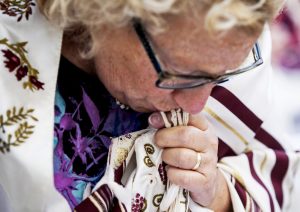
Elders and grandparents — who are often an overlooked resource in enriching the B-Mitzvah celebration and creating a meaningful rite of passage — can step in here. They are caretakers of family stories, legacy, wisdom, experience, and perspective, and often have the time and the desire to help the B-Mitzvah find their place in community.
The journey of study and preparation our teens take on differs from the experiences many of their peers will have at the same age, as our teens incorporate new responsibilities, accountability, and opportunities for growth. Since the process is unfamiliar —it’s not a sports team or a dance class that they may be used to — it opens a new space to engage a teen’s interest, allowing them to wonder about their personal history and wider Jewish heritage. What better guides on this journey than their grandparents or elders, who may remember first-hand their own experiences as teens? With the distance of years and accumulated wisdom, elders can guide teens with love and understanding.
How can we engage grandparents and other elders as the teen prepares to become B-Mitzvah?
After consulting with the teen to hear their preferences and desires, consider the following ways to engage the teen’s grandparents or other elders in the family or community:
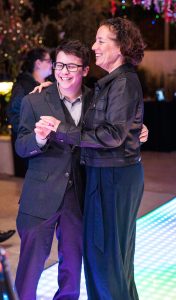
a) Musically: Elders can meet in person with the teen several times, or virtually over Zoom, WhatsApp, or FaceTime, to teach the B-Mitzvah student a melody for a prayer that they sang at their own B-Mitzvah, or at the synagogue/spiritual space they grew up in. This can also be a moment of chevruta (study partnership), during which elders can learn from teens how best to use technology to record the melody to assist in their learning process. The two generations could record themselves singing together.
b) Movement/body: What were special simchah (joyful celebration) dances the elder remembers specifically at their own B-Mitzvah, Quinceañera, confirmation, wedding, or other rites of passage? If able-bodied, perhaps elders can share specific choreography, or the dance could be incorporated into the setlist. Perhaps the teen and elder prepare the dance together and lead the community.
c) Emotionally: Elders can share some of the ways they prepare themselves for a big moment. Maybe an elder in their life used to help calm them, or offer love and support — an affectionate touch, a pat on the arm, stroking the hand, or a huge, reassuring hug. Whatever works to send the message: “You got this.”
How can we engage grandparents and other elders during the B-Mitzvah ritual?
How do we include the elders in the ritual to both witness and celebrate the B-Mitzvah in a meaningful and intentional way? Families, with input from the teens, might consider the following suggestions:
a) Deepen the generational Torah pass: In this ritual the Torah is passed from generation to generation, beginning with the oldest family members, before the Sh’ma is chanted in the Torah service. Gestures or movement can enrich the ritual. Here’s an example: The B-Mitzvah could hold the Torah while walking down the line of elders, pausing before each one. The elder, having prepared in advance, shares out loud (preferably into a microphone) a quality or value they were taught by their own beloved elders and want to continue to pass to the B-Mitzvah. They clearly and visibly share a hand- or full-body gesture that they think represents that value or quality. The entire congregation community then replicates the gesture as the B-Mitzvah watches them.
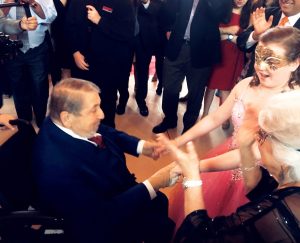
For the value of courage through adversity (ometz lev), for example, the elder might hold up their arms to demonstrate making a muscle. In a remember-love-actively (ahavah) moment, the elder might touch their heart, then head, then hold up their hands. Pointing to their smile or laughing out loud could highlight the value of joy. Simultaneously, the cantor, song leader, choir, or congregation could sing or hum a version of l’dor vador (From generation to generation).
b) Musical connections: The B-Mitzvah sings and leads the community in the prayer or melody their elder taught them during their preparation. The elder can connect to this moment in a variety of ways. If the B-Mitzvah teen agrees, the elder might come up to the bimah to sing alongside the B-Mitzvah or hold a microphone at their own seat and sing along. Before or after the prayer, the clergy could name this moment as a time of specific intergenerational connection.
c) The Dance of the Tallit: The tallit (prayer shawl) is often a key element in the B-Mitzvah rite, in Jewish ritual of prayer and protest[2], as well as in marriage ceremonies. Elders could leave their “love-print” on this object for future use by:
- Walking around the B-Mitzvah teen to wrap them in the tallit, embodying the concept l’hit’atef ba’tzitzit (the blessing recited on putting on the tallit). Less mobile elders can stand or sit in front of the community.
- Sharing an intention, perhaps as follows: “When you were a baby, we wrapped you in a blanket. Now that you’re a B-Mitzvah we put our love into this tallit. From then, to now, until always we want you to feel warm and loved and held.”
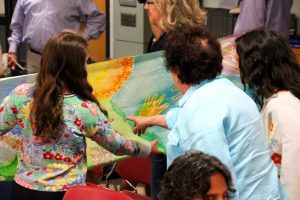 Blessing the B-Mitzvah in an all-hands-bless (Y’varech’cha) A central moment in many communities is when the clergy or parents bestow the y’varech’cha, the priestly blessing, on the B-Mitzvah child. Bringing our elders into the moment can magnify this blessing of protection and peace.
Blessing the B-Mitzvah in an all-hands-bless (Y’varech’cha) A central moment in many communities is when the clergy or parents bestow the y’varech’cha, the priestly blessing, on the B-Mitzvah child. Bringing our elders into the moment can magnify this blessing of protection and peace.- Forming a semi-circle around the B-Mitzvah (standing or seated). The elders take on the role of the ancient priests, hands lifted as an opportunity to activate a commitment for more responsibility. The B-Mitzvah commits to focusing more intently on the elders’ place in the teen’s lives. The ritual can be extended to including commitments between elder and B-Mitzvah or a focus on particular community values (for example, respect (kavod), kindness (chesed), welcoming strangers (hachnasat orchim).
How can grandparents and other elders celebrate the accomplishment of the B-Mitzvah’s hard work?
The physical act of celebration through dance and music has been central to powerful moments of separation, transition, and reintegration throughout ancient and modern Jewish history. Music and dance catalyzed celebration in the Torah story of the splitting of the sea (Exodus 15:1-18). At the return of the Aron Kodesh (Ark of the Covenant) to Jerusalem, King David danced without inhibition. (2 Samuel 6:14).

The Levites (sacred Temple technicians) “celebrated a joyful dedication with thanksgiving and with song, accompanied by cymbals, harps, and lyres” at the rededication of Jerusalem (Nehemiah 12:27) At the closing of the Purim story, “the Jews enjoyed light gladness, happiness, and honor” (Esther 8:16). In contemporary times, many communities invite their members to dance and sing at the end of the Yom Kippur Ne’ilah service.
Our prayer service lends itself to moments that can be celebrated with song and dance: perhaps when the Torah service is completed; after the rabbi has blessed the B-Mitzvah, or after the family has recited the Shehecheyanu blessing that acknowledges arriving at this moment in time. But how do we let go of our protocols — and our inhibitions? Are we too accustomed to being well-behaved in the pews? And is the experience representative of who the family is? Is the horah (a dance with roots in Eastern Europe) or the song, “siman tov u-mazal tov” equally appropriate for Jews of diverse backgrounds?
Other options may include inviting grandparents or other elders:
 a) In body: Invite the elders to sit in the middle of the dance circle, perhaps on a specially decorated chair. This is an opportunity to keep our elders in the forefront of our minds amidst the exchange of positive smiles, clapping, and energy, while also minimizing their fear of being trampled. Able-bodied folk might lead a dance that has meaning for them or the family.
a) In body: Invite the elders to sit in the middle of the dance circle, perhaps on a specially decorated chair. This is an opportunity to keep our elders in the forefront of our minds amidst the exchange of positive smiles, clapping, and energy, while also minimizing their fear of being trampled. Able-bodied folk might lead a dance that has meaning for them or the family.
b) Spiritually through evocative music: In advance prepare and include a musical piece or two at the celebration or party that connects the generations.
c) In voice: Depending on personality and personal choice, a grandparent or other elders could have MC (master of ceremonies) moments, introducing family members, rituals, and music at the party. If appropriate, they could also say some words about the B-Mitzvah.
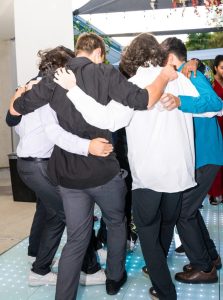
These ideas can help families find ways to embrace music, movement, and dance as central elements of Jewish ritual and celebration as well as honoring and integrating grandparents and other elders into the celebration as the B-Mitzvah steps into this next stage of life.
What a powerful sense of hope and deep Jewish tradition can emerge from merging our elders’ history, perspectives, and ideas; the teen’s own interests and desires; and music, movement, and dance, as we integrate the B-Mitzvah teen into our loving communities.
Naomi Less is a Brooklyn-based, internationally celebrated singer/songwriter, ritualist and educator. Her original music is sung in worship communities worldwide. Naomi serves as Co-Founder, Associate Director, Ritual Leader at Lab/Shul and directs their Raising the Bar B Mitzvah program rituals. She received training in spiritual leadership from the Institute for Jewish Spirituality and a masters in Jewish Education from the Jewish Theological Seminary. Naomi was Rising Song Institute Fellow and serves as a Core Educator at Songleader Boot Camp. She amplifies the voices of women and non-binary folks on her Jewish Women Rock show on Jewish Rock Radio. Naomi passionately advocates for people struggling with fertility journeys as a performance artist and speaker for Uprooted: A Jewish Response to Fertility Challenges. You can find her music on Spotify or anywhere you stream.
Tehilah Eisenstadt directed education programs in Reform, Reconstructionist, Conservative, Renewal, Open Orthodox Montessori and JCCs. Tehilah mentored new directors and teachers throughout the Jewish world and “Cordoba House,” a Muslim school in NYC. She consulted for Netflix’s Charlie’s Colorforms City and is a non-denominational Mikvah Guide, for ImmerseNYC. Tehilah received her MA’s in Jewish Education, and in Midrash from JTS. She is building a non-profit that center on rituals and community building that grow individuals’ wonder and healing, in Jewish and interfaith spaces. Tehilah is a Mandel Institute Fellow and rabbinical student at AJR.
Photographic Credits
Conga line dancing, wheelchair dancing, and making tallitot by Stephanie Fink
Blessing the teen, adult and teen dancing, adult in chair, and teen huddle by Sadie Braunstein
Elder bringing tzitzit to lips by Yochi Rapperport, courtesy of Wikimedia Commons
[1] Not every B-Mitzvah teen chants from the Torah. For example, at Lab/Shul, all learners learn to translate the Torah into their own words, reenacting the ancient act of the Meturgeman — the Torah Translator, part of Jewish prayer communities for centuries.
[2] The tallit has come to exemplify “praying with their feet, when Jews wear them at rallies — to clearly identify themselves as a Jew called to protest.

